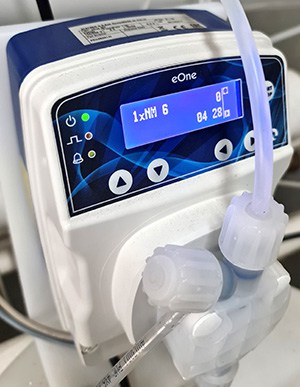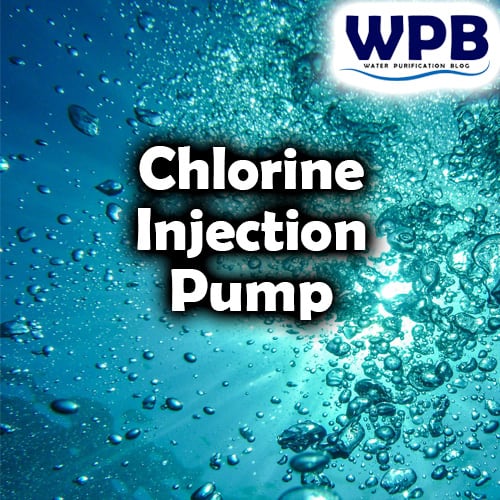Chlorine Injection Pump – Chemicals Dosing Explained
A chlorine injection pump is an important component of many water treatment systems. It is responsible for injecting the right amount of chlorine into the water to maintain a safe level of water disinfection and provide microbiologically safe water.
The pump is a part of a chlorine injection system and it helps to ensure that chlorinated water is free from iron bacteria, other harmful bacteria and microorganisms that could cause health problems.
Also, a chlorine injection pump is often used for chlorine dosing in front of Greensand filter media for iron, manganese, hydrogen sulfide, and arsenic removal systems.
Table of Contents
What is a Chlorine Injection Pump?
A chlorine injection pump is a type of positive displacement pump that injects chlorine into water at a precise rate. It is an equipment used in water treatment systems to ensure that the water is safe for consumption.
There are two types of applications of chlorine injection pumps: diaphragm pumps and peristaltic pumps.
Diaphragm pumps use a flexible diaphragm in the pump head to push the chlorine into the water, while peristaltic pumps use a series of rollers to squeeze the tubing and move the chlorine.

How Does a Chlorine Injection System Work?
A chlorine injection system works by injecting a precise amount of chlorine into a water system, by a membrane movement that is located in the pump head.
In the pump head, the chlorine solution is taken to a higher pressure than the water pressure in the installation pipes. This way it is discharged directly into the installation.
The pump is typically controlled by a contact water meter or a programmed timer within the pump, which regulates the time and amount of chlorine that is injected into the water.
The pump draws the chlorine from a solution tank and injects it into the water piping using the feed line.
The suction is done through the specially designed foot valve, often with an integrated float switch to signal low level of chemical in the tank.
The chlorine is distributed evenly throughout the water installation to kill bacteria or other microorganisms.
Benefits of Using a Chlorine Injection Pump
Using a chlorine injection pump method offers several benefits. One of the main advantages is that it ensures consistent and accurate dosing of chlorine, as a water disinfectant.
Also, it is widely used with different filter media to oxidize iron, manganese, hydrogen sulfide and ammonia.
This is important because too little chlorine can be ineffective in killing harmful microorganisms, and keeping the iron bacteria under control, while too much chlorine can be harmful to humans and pets.
The pump can be set up to operate automatically, which means that there is no need required for constant monitoring.
Finally, using a chlorine injection pump helps maintain water quality and safety standards, which is important for businesses and homeowners who rely on clean water.
Factors to Consider When Choosing a Chlorine Injection System
When choosing a chlorine injection pump, there are several factors to consider. One of the most important factors is the flow rate requirement. This is the amount of water that needs to be treated per hour. Another factor to consider is chemical compatibility. Not all pumps are compatible with all types of chlorine, so choosing a pump that can handle the type of chlorine you’re using is important.
Pump capacity and pressure are also important factors to review and consider, as well as cost and maintenance requirements.
Installation and Maintenance of Chlorine Injection Pumps
Proper installation and maintenance of a chlorine injection system are crucial to ensure its optimal performance.
The pump should be installed by a professional to ensure that it is set up correctly. Regular maintenance is also important, including replacing worn parts, cleaning the pump, and checking for leaks.
Common troubleshooting tips include checking the pump’s power source and flow meter or timer and inspecting the feed line and the storage tank.
Types of Injection Pump Operating Modes
Continuous (Manual) Operation
Continuous operation is one of the most common operating modes for dosing pumps. As the name suggests, the pump operates continuously, delivering a constant flow rate of the liquid or chemical being dosed. This mode is suitable for applications that require a steady and uninterrupted supply of the substance.
How it Works
In continuous operation, the dosing pump maintains a constant flow rate by adjusting the pump speed or stroke length. The pump draws the liquid or chemical from a storage container and pumps it into the process stream at a consistent rate. This mode ensures a continuous and consistent dosage, making it ideal for applications such as water treatment, wastewater treatment, and chemical processing.
Batch Operation
Batch operation involves delivering a fixed quantity of fluid in discrete batches. This mode is suitable for applications where the dosing requirements occur intermittently or in specific volumes. Batch dosing is commonly used when precise control over the amount of substance being added is essential.
How it Works
In batch operation, the dosing pump is programmed to deliver a specific volume of liquid or chemical in each batch. Once the desired volume is reached, the pump stops until the next dosing cycle. This mode ensures accurate dosing in applications where periodic addition of substances is required, such as in chemical reactors, dosing tanks, or laboratory processes.
Proportional Control
Proportional control is a dosing pump operating mode that enables precise control over the dosing rate based on the changes in a water flow. These changes are tracked by a water meter that gives contacts on every liter, 10 liters, 100 or 1000 liters passed through it. This mode is commonly used when the dosing requirements are proportional to a specific flow.
How it Works
In proportional control, the dosing pump is connected to a water meter. The pump adjusts its dosing rate based on the contacts received from the water meter, ensuring that the required chemical concentration is maintained. This mode provides dynamic dosing, allowing for real-time adjustments to achieve optimal dosing quantities.
Pulse Dosing
Pulse dosing is a dosing pump operating mode that delivers fluid in short pulses or bursts. This mode is commonly used when precise and controlled dosing is required in small quantities or at specific time intervals.
How it Works
In pulse dosing, the dosing pump operates by intermittently activating and deactivating to deliver fluid in pulses. The duration and frequency of the pulses can be adjusted to meet the dosing requirements of the application. This mode is particularly useful for applications where a high degree of accuracy and control is needed, such as in analytical chemistry or additive injection in small-scale processes.
What is the Most Common Chlorine Injection Pump Problem?
The most common issue with electromagnetic injection pumps is that air collects in the membrane chamber. This air compensates the pressure that the membrane makes, and the pump is not dosing chlorine in the installation.
When the pump is dosing chlorine like it should, the pipe leading to the installation should move with each stroke. First sign that there is air in the membrane chamber, is that the pipe is not moving during strokes.
The other sign is that the pump sound during strokes has changed.
How to Solve the Problem With Air in the Injection Pump?
Luckily, in most cases the solution is simple.
Most dosing pumps have an air bleed valve. It should be opened and the pump put into a constant dosing mode.
When the air gets out from the pump head, the air bleed valve should be closed.
Now the pump will do the dosing into the installation. If the pipe leading to the installation is moving, and the sound returned to usual, the problem is solved.
The last thing is that the dosing pump should be returned to it’s regular operating mode.
Conclusion
Chlorine metering pumps are an important component of many water treatment systems. Some of the most renowned producers of dosing pumps are Grundfos, Etatron.
A chlorine injection pump ensures consistent and accurate dosing of chlorine, reduces manual labor and helps maintain water quality and safety standards.
When choosing a chlorine dosing system, it’s important to consider factors such as flow rate requirements, chemical compatibility, pumping capacity and pressure, cost, and maintenance requirements.
Proper installation and regular maintenance are crucial for optimal pump performance.

Who am I?
I am working as a water treatment technical manager and I have more than 25 years of practical experience in water purification.
Water purification expert
After many years of experience in water purification, I want to share some of my knowledge and get people to know the real importance of water quality.
Water purification and water treatment are very complex themes, so it is important to explain them in an easy-to-read way.
On this blog, you will find many understandable, easy-to-read information about water purification.
I hope you enjoy it, find some useful information, and thank You for reading.
More info on my work and my expertise on water purification can be found on my LinkedIn profile.

Who am I?
I am working as a water treatment technical manager and I have more than 25 years of practical experience in water purification.
Water purification expert
After many years of experience in water purification, I want to share some of my knowledge and get people to know the real importance of water quality.
Water purification and water treatment are very complex themes, so it is important to explain them in an easy-to-read way.
On this blog, you will find many understandable, easy-to-read information about water purification.
I hope you enjoy it, find some useful information, and thank You for reading.
More info on my work and my expertise on water purification can be found on my LinkedIn profile.






